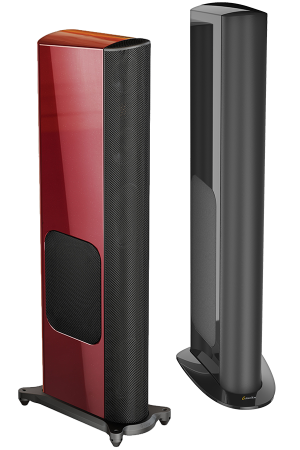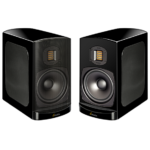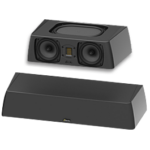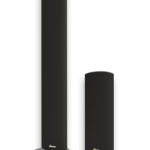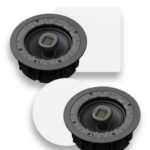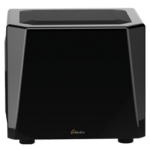FAQs
Although GoldenEar loudspeakers are often praised for their unrivaled combination of performance and value, we believe there are many deeper and more significant reasons for their success.
Every GoldenEar loudspeaker — whether it’s the versatile Invisa HTR 8000 in-ceiling speaker, the practically invisible SPS in-wall speaker, an award-winning BRX bookshelf model, or any of our highly acclaimed Triton towers — is meticulously designed to blend so perfectly into its surroundings that it virtually disappears, exuding nothing but naturally beautiful sound.
Sound first. This mandate extends well beyond the listening environment to equally honor the source material. A good speaker serves the listener and the home. A good speaker serves the music and the soundtrack. A good speaker serves.
A good speaker is not designed to shout the loudest or to grab the listener’s attention in a dealer’s sound room — unless the audio dictates it. A good speaker is designed to seduce, or inspire, or scare the daylights out of you — as the source demands.
While it’s absolutely true that all speakers benefit from attention to placement, room treatments, partnering amplification, and other variables, GoldenEar speakers are made to be significantly less sensitive to these particulars. We demand that our loudspeakers accommodate the listener’s home and lifestyle — not the other way around.
We pay special consideration to our state-of-the-art drivers, advanced crossover networks, and complex internal bracing — all of which are designed from the ground up, by and for GoldenEar. But that effort and expense would be for naught if the designers didn’t have a clear view to the most desirable result and an expert knowledge of how to get there. These are loudspeakers not made by so-called “golden ears,” but loudspeakers made to have a golden voice — loudspeakers that you can enjoy easily over long periods of time, without the frustration and fatigue that too often come from artificial detail, bloated bass, murky mids, and other offensive distortions.
Our speakers neither require nor make apologies. With a pair of GoldenEars, all you’ll ever need to do is sit back, relax, and — ahh! — reconnect with your favorite music… Or — wow! — grab the edge of your seat and hold tight as you’re transported into an exciting new film.
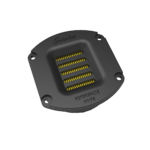 We’re sure that Henry Ford got asked “Why not a horse?” more than a few times during that time of change as well. The automobile was a better, new technology – and in the same way that the horse gave way to the auto, the old horn-loaded dome (and even older horn) tweeters, will give way to the better, new technology air-motion tweeters. GoldenEar’s High Velocity Folded Ribbon (HVFR) tweeter couples much more efficiently with air and its non-resonant diaphragm has virtually no moving mass. With none of the piston-like motion issues of domes, a much larger acoustic surface area for significant output abilities, as well as excellent dispersion, the GoldenEar HVFR tweeter is a sonic (and measured performance) marvel.
We’re sure that Henry Ford got asked “Why not a horse?” more than a few times during that time of change as well. The automobile was a better, new technology – and in the same way that the horse gave way to the auto, the old horn-loaded dome (and even older horn) tweeters, will give way to the better, new technology air-motion tweeters. GoldenEar’s High Velocity Folded Ribbon (HVFR) tweeter couples much more efficiently with air and its non-resonant diaphragm has virtually no moving mass. With none of the piston-like motion issues of domes, a much larger acoustic surface area for significant output abilities, as well as excellent dispersion, the GoldenEar HVFR tweeter is a sonic (and measured performance) marvel.
GoldenEar speakers will sound great right out of the box, but be prepared for some further improvements during the first 100 hours of playing time. Although there is nothing “breaking in”, critical listeners all agree that during the first 100 hours of use there are audible changes and subtle improvements in sound quality in any high-performance speaker system.
GoldenEar speakers are sold across North America through a network of authorized dealers. None of our products are offered for sale by Mail Order. GoldenEar provides a warranty only on products sold by our authorized dealers. Click here to go to the dealer locater page to find your closest authorized GoldenEar dealer.
Nothing, in that a well designed, good sounding pair of speakers will sound good on both Music and Movies. Although not practical for most Home Theaters, movie sound production studios will often use five to seven of the exact same speaker (plus subwoofers), for their playback monitoring during the mixing process. A great sounding home theater should consist of a great sounding pair of speakers combined with performance and fidelity-matching center and surround/rear speakers. This will also insure you can enjoy both movie soundtracks AND music on your high performance audio/video system. This applies to anything but the very largest (commercial-sized, not “Home”) Theaters. In very large spaces there are other considerations that do not play out in even the largest of residential in-home theaters.
In today’s world of discreet, high-resolution multi-channel sources, the rear speakers in a home theater system should have all the attributes and performance of the main speakers. However, given the typical room placement options* for rear and surround speakers, these speakers will typically need to be small and therefore bass performance will be relegated to the system’s subwoofer(s). Beyond bass extension, they should be as full-fidelity as your front speakers.
*Most often, surround and rear speakers are mounted on the wall. For best effect, surround and rear speakers should be mounted as high as possible in the room.
The center channel is the most important speaker in a Home Theater system. It produces all of the voices that come from actors on the screen. Choosing a center channel speaker with great high-fidelity gives you the added benefit of something called “dialog intelligibility”, or the ability for the listener to clearly hear what is being said in the movie dialog. As with rears and surrounds, typical placement options in most home theaters require that the center channel speaker be horizontal rather than vertical. This means the speaker must have been specifically designed to be used in a horizontal configuration, just putting a vertical speaker sideways will not yield the necessary fidelity and desired dialog intelligibility for multiple listeners in the Home Theater.
That depends on what main speakers, the location of the subwoofer in single subwoofer systems, and what fits best for your setting.
Over the years we’ve found that many customers’ home theaters actually need small and unobtrusive center channel speakers. The SuperSat 60C and 50C are just such products. While they don’t reproduce the lowest registers by themselves, the Triton Two and Three based cinema systems already have a great solution to help them do so: the twin powered bass sections of the Left/Right Triton Towers! When you set up a TritonCinema system the Triton’s powered bass section handles the center channel bass information. By setting the Tritons to LARGE, the SuperSat 60C or 50C center channel to SMALL (with the suggested 120 Hz crossover, which will allow the 60C/50C to play as loud as the Tritons), and the Subwoofer to NONE, the receiver/processor will take care of directing the center channel bass information (which is mono) to the left and right main Triton speakers. Because you have two Tritons, the center channel bass will appear to come from right between them… right there with the center channel! It’s just like listening to a mono recording – everything appears to come from the center in between the two main speakers. It’s actually like having a virtual or phantom center channel subwoofer. Now the SuperSat 60C or 50C center channel will have great dynamic range and will sound like BIG, full-size, full-range speakers, but in the small, (and wall mountable) package many people need to “fit” in their space. Although the SuperSat 60C/50C speakers are designed to look very small, the drivers have been optimized to have very similar acoustic characteristics and output to the Triton Tower drivers. Looks can be deceiving, since GoldenEar has both the experience and facilities we had the pleasure to design all the drivers for the complete GoldenEar product line starting from scratch in our in-house laboratory, for a no compromise match in performance (timbre, dispersion characteristics, and output levels). So, the Tritons and SuperSat 60C/50C were, so to speak, “made for each other”.
If you have room for a full size center, or if you are using the Triton Seven or Aon bookshelf speakers as the L/R main speakers in your GoldenEar home theater with an outboard ForceField subwoofer, the larger SuperCenters are the ideal choice. These wider frequency range center channel speakers allow for a lower crossover point when used in a home theater setup that includes a subwoofer. This can be especially worthwhile if the single subwoofer is placed far away from the center speaker. Most importantly, the SuperSats and the SuperCenters are all designed to produce the same spectral response as the Tritons and Aons, with the same tonal balance from the limits of their lower range through to the top end. Their performance is a perfect match for the Triton Series Towers and the Aon Series Bookshelf speakers.
The subwoofer is an integral part of today’s home audio/video systems, especially the very popular “Sub/Sat” music and home theater systems category. Years ago, the word subwoofer meant a speaker that produced sounds deeper than a regular woofer. Often times now the term has come to mean the largest driver in a system, regardless of whether the system has a real bass woofer or not. In the case of today’s definition of subwoofer, and our use here, a subwoofer will be a powered low bass device designed to take on all the bass requirements of a movie and/or music system. In the case of GoldenEar, this includes both our standalone powered subwoofers as well as the powered subwoofers built into the Triton loudspeakers.
Standalone Powered Subwoofers allow the main speakers to stay relatively small, critical in many of today’s home environments. For full size speakers, built-in powered subwoofers are the only way to get full frequency response performance from a reasonably sized and priced floorstanding loudspeaker. Thanks to high-powered digital amplifiers, advanced materials for bass driver design, and DSP (digital signal processing) available today, GoldenEar’s subwoofers produce significant amounts of bass output with higher fidelity than ever before possible from modest sized and priced designs.
The placement of a sub isn’t critical because subwoofer bass frequencies are non-directional, the listener can’t determine what direction the subwoofers sound is coming from. The subwoofer is often placed in the corner of the room because it gives the most bass output from that location. Although the corner of the room works fine in many cases, a powered sub with significant output and bass extension, like the GoldenEar ForceField subwoofers, allows for flexible placement anywhere in the room.
Yes. Bass is the “body” of the music and the impact of special effects – without it music sounds empty and movies underwhelming, exactly when they should be most involving. For music, many full range speakers have adequate bass without a subwoofer. However, unless the speaker has a built-in powered subwoofer, it will not be capable of the kind of bass volume and impact the movie experience requires. The other important advantage of having a subwoofer in your system is that the rest of the speakers can be much smaller – a critical factor for may living spaces.
No. A good sounding pair of front speakers makes a much better sounding home theater system than a bad sounding surround speaker system. And that good sounding stereo pair may be a great start to a full high fidelity home theater system – just add an equally high-fidelity center speaker* and surround/rear speakers, and a powered subwoofer (if your stereo pair doesn’t have one built-in) and you’re at the movies! It is worth noting, however, that if your stereo speakers are many years old you may be unable to get a good matching center speaker (and technology may have made some significant strides in the sound available from an upgrade to the front speakers – which would also allow you to get a fully matched system at that time).
*It is very important that the center speaker sound the same through the critical midrange, and perform with the same fidelity and dynamics, as the main stereo speakers.
Simple answer: Yes. As mentioned earlier in these FAQ’s, movie soundtrack production studios use the same exact speakers for front, center and rear channels. Although this may be an ideal situation, it is not practical for most home theaters (and very expensive when the speakers are full range). So, when using smaller speakers and a powered subwoofer, it is a good idea to get four of the same speakers, plus a matching center-channel version designed for horizontal use. And if you use large speakers in the front, you will still want to get all of your speakers, with the possible exception of the subwoofer, from the same manufacturer, making sure that the speakers are designed to work together as a home theater set. Usually, this means they use the same drivers for the mids and highs, which gives all the speakers the same general performance and sound quality.
Yes. When Dolby Surround and Pro Logic were prevalent, the typical home theater receiver had less power rear channels than it did for the fronts. Since the rear speakers were not full range speakers, this wasn’t much of a problem. But with today’s full-range and fully discreet multi-channel sources (all 5 or 7 speakers have their own full range channel), many recordings are now designed for systems that have the same power for all speakers. All of today’s contemporary receivers have amplifier sections designed to deliver equal power to all channels.
The subwoofer in a home theater system usually has its own amplifier built into the sub. Since the subwoofer requires very high power to produce significant bass output and depth (often over 1000 watts) it makes good sense for a sub to have its own amp independent of the other channels.
Here are some tips on using (or not using) the LFE-in on Triton models with built-in powered bass sections. As you know, we normally suggest just hooking up Tritons with speaker wire and configuring your processor to “Large” for Left and Right, and Sub set to “No”. This will then feed the LFE signal into the left and right speaker channels where it goes down the speaker wire where the circuitry in the Triton takes it out and feeds it to the built-in sub. The reason why we have always suggested bass management settings of “Large” Left and Right and Sub “No” is that everything is then properly balanced, especially for stereo two channel music listening. There has been much confusion regarding whether or not some receivers are actually doing this, based on the fact that some listeners found the LFE level much more pronounced (to them, better) when they ran separate LFE cables into the Tritons. While there might be some circumstances on some units where the LFE is not fed into the Left and Right channels (such as on a 2.0 system), per industry standards this is always supposed to be the case for multi-channel playback (usually 3.0 or higher). However, we have found this not uniformly implemented in many popular receivers and processors. We have found that some receivers/processors actually attenuate or roll off the LFE channel if subwoofer is set to “No”, in which case running LFE cables and setting the sub to “Yes” (Tritons still as “Large” or full band) is the only way to get full LFE channel bass. For this reason, we now suggest running LFE cables to all powered Tritons, still set Tritons to “Large”, but now Sub is set to “Yes”, and connecting the LFE-out from the receiver/processor to the LFE ins on the Tritons
Another reason to choose this approach is that when you say Sub “No”, the LFE signal is sent into the Left and Right channels at a level predetermined by the electronics manufacturer and not variable by the user, as it would normally be when the LFE-out is used (Sub set to “Yes”). Some listeners may want a higher (or lower) LFE level than the standard setting. Using the LFE-out, will allow you to set a higher (or lower) LFE level by using the receiver/processor’s subwoofer level adjustment.
Also, please note that some processors have a setting (called variously super bass, bass plus, etc., or perhaps even running all the time), that even with a setting of “Large” Left and Right, in two channel mode the low bass is sent both to the left and right speakers and the sub. The problem here is that if you have speakers with extended bass, like the Tritons, you will have too much bass and it will likely sound boomy or muddy. In the case of the Tritons, if you use the LFE input and one of these “bass plus” settings, the Tritons will basically be sent double the bass signal on two channel music.

